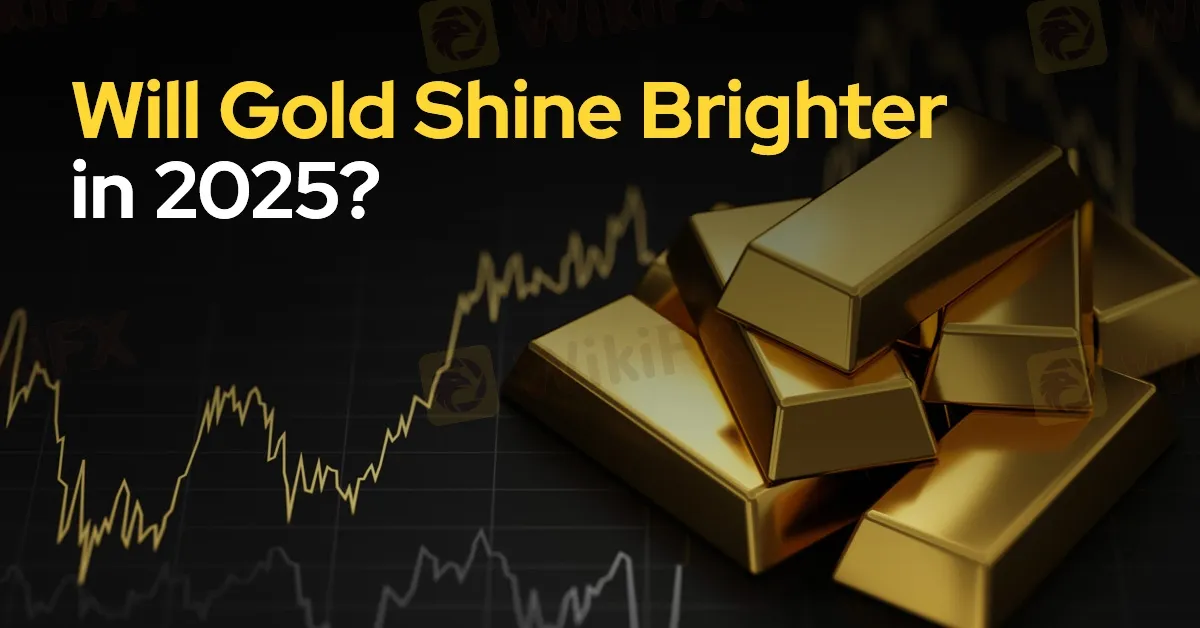简体中文
繁體中文
English
Pусский
日本語
ภาษาไทย
Tiếng Việt
Bahasa Indonesia
Español
हिन्दी
Filippiiniläinen
Français
Deutsch
Português
Türkçe
한국어
العربية
Will Gold Shine Brighter in 2025?
Abstract:Gold is poised for significant gains in 2025, with experts predicting its price to climb between US$2,900 and US$3,000 per ounce or potentially higher. Analysts attribute this optimistic outlook to sustained gold purchases by central banks, ongoing geopolitical tensions, declining global interest rates, and persistent economic uncertainties. These factors, coupled with gold’s status as a hedge against inflation, underline the precious metal’s appeal in volatile times.

Gold is poised for significant gains in 2025, with experts predicting its price to climb between US$2,900 and US$3,000 per ounce or potentially higher. Analysts attribute this optimistic outlook to sustained gold purchases by central banks, ongoing geopolitical tensions, declining global interest rates, and persistent economic uncertainties. These factors, coupled with gold‘s status as a hedge against inflation, underline the precious metal’s appeal in volatile times.
Juwai IQIs chief economist Shan Saeed projects gold prices could rise even further, reaching between US$3,000 and US$5,000 per ounce by next year. He remains confident in gold's long-term performance, describing it as an asset class free of counterparty risk. Shan highlighted that the demand for gold remains robust due to favourable macroeconomic conditions. Citing the World Gold Council, he noted gold prices are expected to grow by an average of 5% annually until 2040. Drawing parallels with the stagflation period of the 1970s, when gold saw average annualised growth exceeding 30%, Shan questioned whether such remarkable growth could be replicated in the current era.

Gold‘s performance in 2024 provides a strong foundation for future optimism. In October, the metal reached an all-time high of US$2,790 per ounce, marking a 35% increase year-to-date before stabilising at around US$2,650. Central banks significantly contributed to this momentum, with India, Turkiye, Poland, and China emerging as major buyers in the first three quarters of the year. India acquired 77 tonnes, Turkiye 72 tonnes, Poland 69 tonnes, and China 30 tonnes, underscoring the global institutional faith in gold’s enduring value.
Investment banks and economists also share this bullish sentiment. UBS targets gold at US$2,900 per ounce by the end of 2025, while Deutsche Bank expects strong physical demand to keep prices steady at around US$2,800. JP Morgan forecasts an average price of US$2,950, citing golds role as a hedge against inflation and economic disruptions. Similarly, OCBC Bank maintains its 12-month target at US$2,900 per ounce.
From a regional perspective, Habib Group executive chairman Datuk Seri Meer Habib highlighted golds reputation as a reliable investment. Despite a slight dip in demand for gold jewellery, investment-grade gold remains highly sought after. Meer anticipates a surge in demand next year, driven by salary increments in Malaysia and global economic trends. He predicts geopolitical tensions in the Middle East and escalating trade disputes between the United States and China will further support gold prices, projecting an increase to US$2,900 per ounce by year-end.
However, Meer acknowledged potential challenges to golds appeal. Rising inflation, subsidy rationalisation in Malaysia, and a strong US dollar could limit demand. He added that a robust stock market might divert investor interest from gold. Furthermore, easing global tensions could reduce the safe-haven demand for gold, which traditionally thrives during periods of uncertainty.
Despite these challenges, gold remains a preferred asset for many investors, offering protection against inflation and economic instability. As the world continues to navigate an unpredictable economic landscape, gold is likely to remain at the forefront of investment strategies in 2025.

Disclaimer:
The views in this article only represent the author's personal views, and do not constitute investment advice on this platform. This platform does not guarantee the accuracy, completeness and timeliness of the information in the article, and will not be liable for any loss caused by the use of or reliance on the information in the article.
Read more

OPEC's Profound Influence on the Oil Market
At present, oil prices remain relatively stable, but global economic recovery and shifting market demands continue to drive price fluctuations. Amid an uncertain global economic and geopolitical landscape, OPEC’s policies and actions remain key determinants of oil prices.

What Are The Top 5 Cryptocurrency Predictions For 2025?
Discover the top 5 cryptocurrency predictions for 2025, including Ethereum's rise, a potential bear market, meme coin struggles, and regulatory shifts.

What Euro Investors Can't Afford to Miss
For euro investors, geopolitical factors, inflation data, and the European Central Bank's policy direction will determine the market trends over the next few months.

How Big is the Impact of the USD-JPY Rate Gap on the Yen?
The U.S. Federal Reserve's repeated rate cuts and the narrowing of the U.S.-Japan interest rate differential are now in sight. So, why is the U.S.-Japan interest rate differential so important for the yen’s safe-haven appeal, especially when global economic uncertainty rises?
WikiFX Broker
Latest News
Will Gold Break $2,625 Amid Fed Caution and Geopolitical Risks?
ECB Targets 2% Inflation as Medium-Term Goal
New Year, New Surge: Will Oil Prices Keep Rising?
PH SEC Issues Crypto Guidelines for Crypto-Asset Service Providers
FTX Chapter 11 Restructuring Plan Activated: $16 Billion to Be Distributed
Think Before You Click: Malaysian Loses RM240,000 to Investment Scam
Bithumb CEO Jailed and Fined Over Bribery Scheme in Token Listing Process
WikiFX Review: Something You Need to Know About Saxo
Is PGM Broker Reliable? Full Review
Terraform Labs Co-founder Do Kwon Extradited to the U.S. to Face Fraud Charges
Currency Calculator






